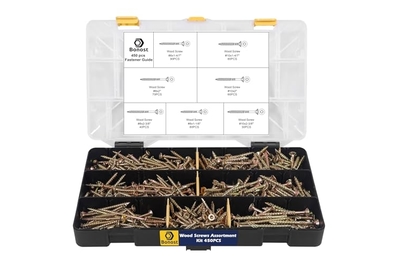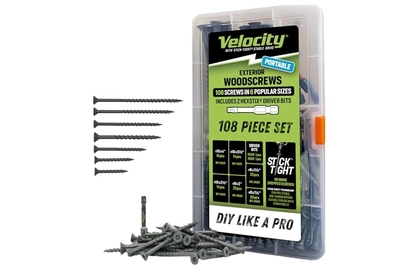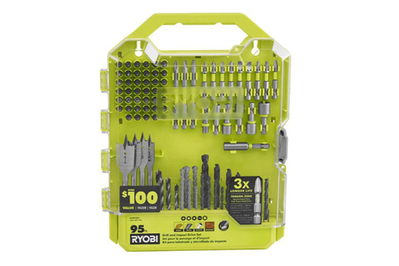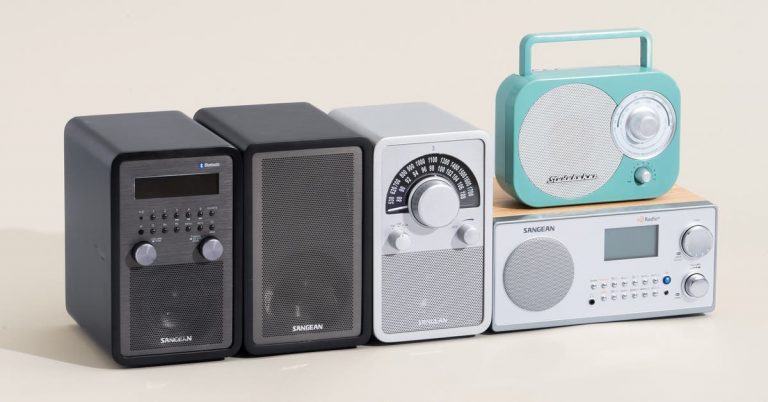Torx Screws: The Best Screws You’ve Never Used
When I took on my first significant DIY carpentry project earlier this year (a shed-sized playhouse for my daughter), I was let in on a secret: Pros swear by Torx-head screws, an all-around better alternative to the formerly ubiquitous but flawed, finicky Phillips head.
If, like me, you’ve ever felt like you’re fighting your drill or screwdriver, allow me to let you in on another secret: Your beef was actually with Phillips-head screws.
The cross-headed design of the Phillips screw is notoriously slippery and easy to damage. That’s why most of the rest of the world moved on from Phillips screws years ago, if they even adopted this miserable standard in the first place.
This isn’t a problem with Torx because the star-shaped head provides much better grip and stability. Torx screws usually stay put on the end of your tools without being held in place, so it’s easier to work with just one hand on your tool, even at weird angles. And all that extra contact between the screw and the drill bit makes it much less likely that you’ll strip the head (or ruin your bit) even if you’re blasting your tools at full speed.
Over the course of my project, I sank more than 100 Torx screws into all types of wood without rounding out a single head. And I only occasionally fumbled a screw off the tip of my driver. Torx saved me at least an hour of work and untold frustration.
I’m a Torx convert. I even look for excuses to swap out old Phillips screws for their star-drive cousins, like I did when I shored up some loose screws on a door hinge.

Although Phillips screws have been the norm in the US for almost a century (thanks to the automotive industry adopting the standard en masse in the 1930s), today there aren’t many credible technical or legal excuses to keep using Phillips screws. The patents on Torx (and other Phillips-beating standards, including square drive) expired decades ago, so anyone can manufacture the bits and screws.
Phillips apologists sometimes claim that bit slippage (or “cam out”) — where your drill or screwdriver slips out of a Phillips head once you apply a certain amount of torque — is actually a great feature that prevents wrist injuries, tool damage, and over-tightening. But even basic power tools now have built-in workarounds for those problems.

Torx’s star began to rise among carpenters and home builders in the mid-2010s, alongside the growth of affordable cordless impact drivers, said Brian Mertel, senior vice president of product management for Ryobi North America.
An impact driver looks like a stubby drill, but it sinks screws into wood and other materials at breathtaking speed. (Even basic power tool starter packs usually come with one now.) That tool’s efficiency is often wasted on wobbly, damage-prone Phillips screws, so it makes sense to pair an impact driver’s extra power with a snugger standard like Torx.
Many working professionals and serious DIYers in the US have already made the switch to Torx for tons of tasks (with exceptions for drywall and some finish work). “Best thing to happen to construction since hammers,” says Doug Mahoney, a Wirecutter home-improvement writer, as well as an avid DIY home renovator and a former carpenter, of Torx screws.
Doug says that in the past 18 months that he’s been working on his New Hampshire house, he hasn’t had to replace any of his Torx bits because they take a long time to wear out. “Phillips, on the other hand, I go through like a box of tissues.”

If you’re more of a dabbler or DIY-lite type, the shift toward Torx might not be so obvious. I still thought of them as those vaguely mysterious, tamper-resistant security screws for professionals with specialized tools. That is, until I went to Home Depot to stock up on supplies for my playhouse project and realized that almost every big box and bucket of construction screws is Torx now.

But on the opposite side of the fastener aisle, where the tiny plastic bags of store-brand screws hang from hooks, it’s still predominantly Phillips. “Star-drive screws can be more intimidating” to casual DIYers, said Scott Moore, a fastener merchant for The Home Depot. The little bags of screws are there “for smaller projects, so the star-drive screws aren’t needed,” said his colleague Matt Giorgis.
Fair enough. You don’t need Torx screws for simple projects, just like you don’t need an impact driver. But once you already have them, there’s no reason not to use them, and they’ll make your projects that much smoother.

While Torx screws are most commonly sold in large boxes of single, construction-oriented sizes, I’ve found some homeowner-friendly variety packs that include a few hundred screws across multiple lengths and thicknesses, at a modest cost per screw. A box like this should carry you through several small projects of all types, like hanging curtain rods or shelves, for example.
Star-drive bits are a dime a dozen now, so you don’t have to spend much money to get started as long as you own some kind of drill or multi-bit screwdriver. Every box of Torx screws that I’ve picked up since my conversion has come with at least one compatible bit.
Nearly all of the screwdrivers we recommend at Wirecutter also come with multiple Torx bits, as do our favorite drill bit kits. Even light-duty electric screwdrivers ship with a full complement of the six-pointed star drives.
Runner-up
If you can’t find Torx screws in the size or quantity or design you want, you can still probably find something better than plain ol’ Phillips. Square drive and hex drive are both relatively common, for example. While they’re still more likely to strip out than Torx, they don’t slip like Phillips does, and if you aren’t blasting them into two-by-fours with an impact driver, they’re probably fine.
And of course, when I do still have to use Phillips screws from time to time, I manage. But now that I know what a better screw feels like, I wish I didn’t have to.
This article was edited by Megan Beauchamp and Ben Frumin.









